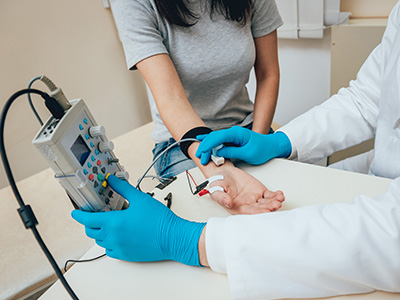Unlocking the mysteries of muscles: Electromyography explained
 Ever felt a strange twinge or weakness in your muscles and wondered what’s going on beneath the surface? Electromyography (EMG) is one of the tools a Rowan-Virtua NeuroMusculoskeletal Institute physician can use to diagnose the issue.
Ever felt a strange twinge or weakness in your muscles and wondered what’s going on beneath the surface? Electromyography (EMG) is one of the tools a Rowan-Virtua NeuroMusculoskeletal Institute physician can use to diagnose the issue.
What is electromyography (EMG)?
EMG is a diagnostic tool that measures the electrical activity in a patient’s muscles and in the nerves that control them.
How does EMG work?
During an EMG test, doctors place electrodes on a patient’s skin or insert fine needles into their muscles. These electrodes pick up electrical signals generated when muscles contract or relax. By analyzing these signals, doctors can detect abnormalities in muscle or nerve function.
“First, we test the nerves and calculate a conduction velocity. This tells us if there is any unusual slowing of the nerves. This is done with electrodes and small shocks,” explains Ian Maitin, MD, a physician at Rowan-Virtua NMI. “Second, we use a pin to evaluate the status of muscle. This tells us if there is any injury to the nerve feeding the muscle, or injury to the muscle itself.”
Does EMG hurt and is it safe?
Patients often fear that the EMG study will be painful. While it can be mildly uncomfortable, most patients tolerate the EMG with no problem. Physicians at Rowan-Virtua NMI work to accommodate a patient's tolerance and adjust to make them comfortable.
In terms of sterility, everything used for the study (electrodes, EMG pins) is disposable, minimizing infection risks. The duration of the study is less than one hour.
Who is a candidate for EMG?
Physicians order EMG for a variety of reasons as they seek to diagnose neuromuscular pathology. A patient with neck or back pain that may be related to a pinched nerve (radiculopathy) may be referred to Rowan-Virtua NMI for EMG to evaluate their neck, back, and extremities. An accurate diagnosis of what level of nerve roots are injured will facilitate treatment.
EMG is invaluable for diagnosing a range of neuromuscular conditions. If a patient is experiencing symptoms like persistent muscle pain, weakness, or numbness, EMG can help pinpoint whether the issue originates in the muscles or the nerves. It’s commonly used to diagnose conditions such as carpal tunnel syndrome, muscular dystrophy, Myasthenia Gravis, ALS, Guillan Barre Syndrome and peripheral neuropathies.
But the benefits don’t stop at diagnosis. EMG also helps guide treatment decisions, whether it’s physical therapy, medication, or surgery. It’s a vital tool for developing effective treatment plans and tracking progress over time. In short, EMG gives doctors a detailed look into a patient’s muscles and nerves, paving the way for accurate diagnosis and tailored treatment.
Book an appointment with Rowan-Virtua NMI
Visit our website to find a convenient location near you and book an appointment.
